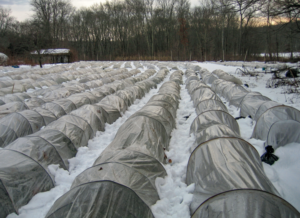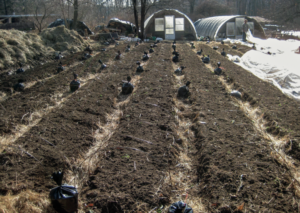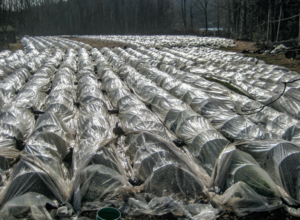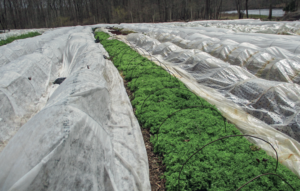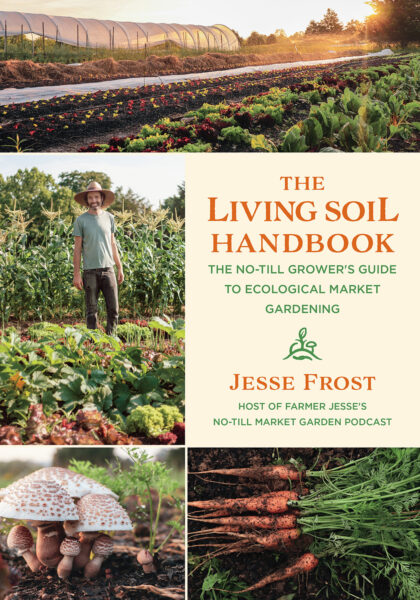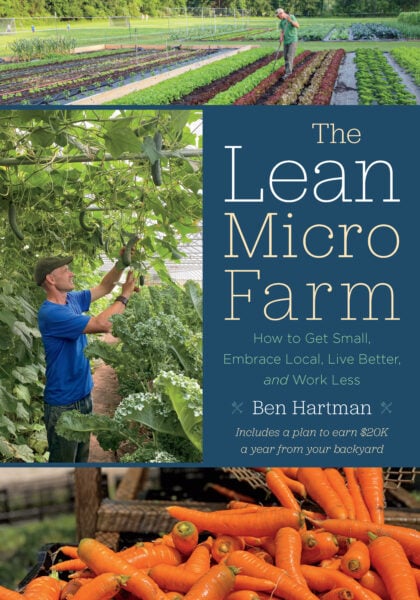Low Tunnel Tutorial: Winter Growing DIY
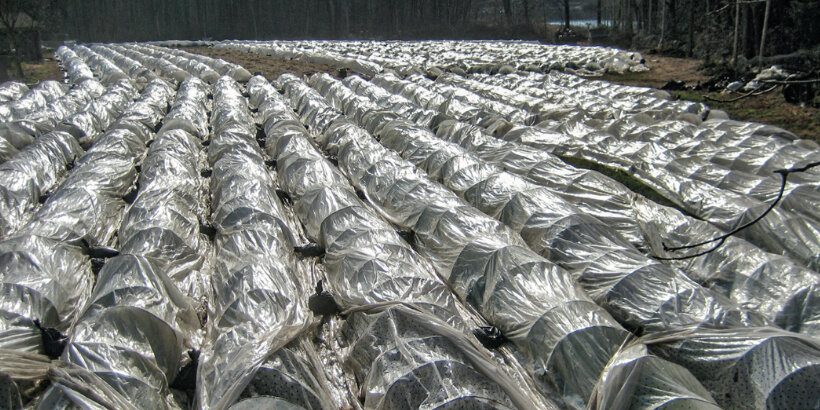
Want to grow year-round, but a greenhouse feels like a big investment? The low tunnel is here to help!
Low tunnels are less expensive than greenhouses and allow you to adjust & respond to the climate outside the tunnel. When it comes to cost and flexibility, low tunnels are the all-around winners.
The following is an excerpt from No-Till Intensive Vegetable Culture by Bryan O’Hara. It has been adapted for the web.
(Photography by Bryan O’Hara)
Low Tunnel vs. Greenhouse
We prefer low tunnels to greenhouses because of the inexpensive nature of the low tunnel and because they allow us to more closely interact with and respond to natural forces as our crops grow.
Initially, the ability to employ a system of mechanized field culture and then shift into winter crop protection mode and back to mechanized field culture was very attractive to us. Over time, however, it has been the ability to better maintain soil fertility that has led us to stick with low tunnels rather than switching to the high tunnels that so many growers employ.
Benefits of A Low Tunnel System
The superior development of soils under low tunnels results from the fact that soils are less cut off from atmospheric conditions than they would be in high tunnels. With a low tunnel growing system, there is a shorter period of coverage when compared with high tunnels.
As well, the soils under low tunnels stay more naturally hydrated through the wicking of moisture that penetrates the ground in the wheel tracks. Thus the tunnel environment maintains a much more natural balance of soil water to air.
Make Your Own Low Tunnel
As described earlier in the book, the standard low tunnel on our farm covers the 36-inch (1 m) wide beds and is 40 feet (12 m) long. This relatively narrow profile allows for greater resistance to snow loads, which can potentially collapse low tunnels.
The 8-inch (20 cm) wheel track between beds provides space to secure the edges of covers on the two bordering beds. The bed length of choice for covering with plastic (polyethylene) row covers is only 40 feet, compared with the 150-foot-long polypropylene covers.
At a 40-foot length, two people can easily pull the plastic covers over the hoops as they work their way down the field. This short length is particularly important when the covers are laden with water and snow in winter, which makes them much heavier. Shorter covers are also less at risk of being loosened and blown off by wind.
Making Hoops for A Low Tunnel
Step 1: Find the Right-Sized and Material Hoops
The thinner-diameter hoops (1/8-inch) are useful for conditions without snow, and of course they are less costly. Hoops with a 3⁄16-inch-diameter can hold up fairly well under snow load, especially if they are closely placed.
Thicker wire hoops and pipe hoops fare the best at resisting snow loads. We use 1⁄4-inch solid steel hoops. The solid nature of these hoops makes them easier to drive into the ground than hoops made out of metal pipe; they are less expensive than pipe as well.
Step 2: If Needed, Make Your Own Hoops
Since precut, bent hoops of 1⁄4-inch-diameter steel are not available on the market, we purchase 1⁄4-inch-diameter round straight stock through metalworking shops and make our own. We bend the cut lengths of steel into a U-shape by hand.
Hoops sometimes become distorted during seasonal use and require a little rebending. It is important to maintain the U-shape, because a consistently arched hoop tunnel with straight sides driven into the earth better resists collapsing under a load of snow.
Note: The steel hoops are not galvanized. We prefer that because galvanized coatings may contain metals that we do not necessarily want to add to our soils. (Most commercially available precut hoops are galvanized.)
Fitting Material to Hoops for A Low Tunnel
Step 1: Figure Out What Size Works Best
Ten-foot (3 m) wide cloth row covers fit over 36-inch (1 m) wide hoops with plenty to spare on the sides for holding down with the sandbags. For many years we used covers that were 8 feet, 4 inches (2.5 m) wide and that was sufficient.
Step 2: Pick Your Material
For plastic sheeting, we utilize 3-mil greenhouse clear plastic for the outer layer and 2-mil perforated clear plastic for the inner layer. Thus we cover each hoop with two layers of plastic. This greenhouse plastic lasts about four seasons of use.
Step 3: Cut Material to Desired Length if Needed
To cut the plastic into 8-foot (2.5 m) widths, we pass a long pipe through the cylinder at the center of the sheeting and then suspend the roll and pipe upon two sawhorses. We hammer a couple of nails into the sawhorse on each side of the pipe to prevent the roll from falling off.
The plastic is measured to locate the 8-foot mark among the folds. Two people hold small sharp knives at these points, cutting the plastic as another person pulls one end of the sheeting down the field.
All low tunnel covers are cut to 50 feet. This provides for covering 40-foot (12 m) beds with enough extra to cover the endwalls and to extend a few feet farther along the ground surface, providing a lip of plastic that can be secured by sandbags when needed.
Setting Hoops in the Field
We start to set up clear plastic low tunnels beginning in October when frost becomes a threat. At first, we might set only the perforated plastic cover; it limits wind and excess moisture while still allowing most of the sun’s light energy to reach the crop. When additional heat is required, we add the solid plastic layer.
The two-layer cover is a great advantage here, because we can pull back the outer cover, leaving only the inner cover in place. Crops growing in such a warm, humid, windless manner cannot be suddenly exposed to outside conditions without being damaged. The perforated cover provides an intermediate condition between fully covered and uncovered.
Step 1: Place Sandbags in Proximity Alongside the Beds
This allows us to avoid the awkward task of carrying sandbags down the wheel tracks when the hoops are already in place. We place five bags along each side of a 40-foot (12 m) tunnel, one at each end, and three down the row at 10-foot (3 m) intervals. More may be required in windy locations, less if we’re covering hoops with cloth row cover instead of clear plastic.
Step 2: Set Your Hoops
Spacing of hoops depends on the conditions: 2 feet (60 cm) apart for good snow load resistance; 4 feet (1.2 m) if no snow load is anticipated. One person holds several hoops in one hand while walking backward along a wheel track. A second person walks along the other side of the bed.
The first person flips the end of hoop across the bed to their partner, who sets the hoop at the proper spacing and drives their end into the ground three or so inches. The person holding the hoops then drives their end in, takes a step or two backward, and flips another hoop end over to their partner.
Step 3: Apply Your First-Layer Material
For plastic-covered low tunnels, once the hoops are set the perforated covers are stretched out along the side of the area to be covered. This also requires two people, one at each end of the 40-foot bed sections. We pick up a cover, move it down the field, and stretch it over the hoops covering a bed.
The cover must be placed evenly side-to-side and along the full length. The partners apply tension along one side, place the end sandbags, then bring tension to the other side and place the next end sandbag.
Step 4: Continue With Your Second-Layer Material
We cover each perforated cover with a solid plastic cover, using the same technique.
Step 5: Secure Your Sandbags
Once the solid covers are all in place, the middle bags down the bed are then set since the bags are now underneath the plastic.
This requires pulling the bags up between the two layers of interlaying plastic and then using our feet to make sure the plastics are again laying fully across the wheel track, and placing the bag back down upon the overlapping plastic. This technique works well for placing and securing cloth row covers over hoops, too.
In the Spring…
As temperatures warm up in the spring, we remove the covers in stages. First, the solid cover is more and more frequently left off. Eventually the perforated covers can also be removed.
When it is time to remove the perforated cover altogether and expose the crops to the outdoor environment for the rest of the growing season, we watch the weather forecast.
It’s best to make this change when conditions are cloudy so as to more gently introduce the plants to the outdoor environment. We pull the covers out of the field and lay them out to dry to a fair degree. They are then rolled up and stored.
It is particularly important to expeditiously remove the plastic covers from the field. If left sitting in the wheel tracks in warm conditions, they pool water, which attracts and drowns earthworms. This quickly begins to smell very bad!
Recommended Reads
Recent Articles
Asparagus is a delicious vegetable with a layered history. How did this aspiring spear make its way from growing in the wild to appearing on our plates? The following is an excerpt from the The Seed Detective by Adam Alexander. It has been adapted for the web. “Nature gives us the key to every secret…
Read MoreInterested in growing trees? Here are some tips on successfully planting, transplanting, and pruning trees to create a flourishing forest garden! The following is an excerpt from The Home-Scale Forest Garden by Dani Baker. It has been adapted for the web. Planting Potted Trees and Shrubs If you order potted trees, check with your supplier to…
Read MoreWith the right strategies and practices, composting on a small farm is surprisingly easy and inexpensive. Just follow these steps for making compost, and your farm will be thriving in no time! The following excerpt is from The Lean Farm Guide to Growing Vegetables by Ben Hartman. It has been adapted for the web. (All photographs by Ben…
Read MoreGarlic mustard: while known as “invasive,” this plant can be consumed in its entirety and has great nutritional value. Plus, the garlic-flavor is a perfect addition to any recipe that calls for mustard! The following are excerpts from Beyond the War on Invasive Species by Tao Orion and The Wild Wisdom of Weeds by Katrina…
Read MoreEveryone loves a refreshing, fermented, nutritious drink…even your garden! Take your fermentation skills out of the kitchen and into the garden by brewing fermented plant juice. The following is an excerpt from The Regenerative Grower’s Guide to Garden Amendments by Nigel Palmer. It has been adapted for the web. How to Make Fermented Plant Juice Fermented…
Read More

